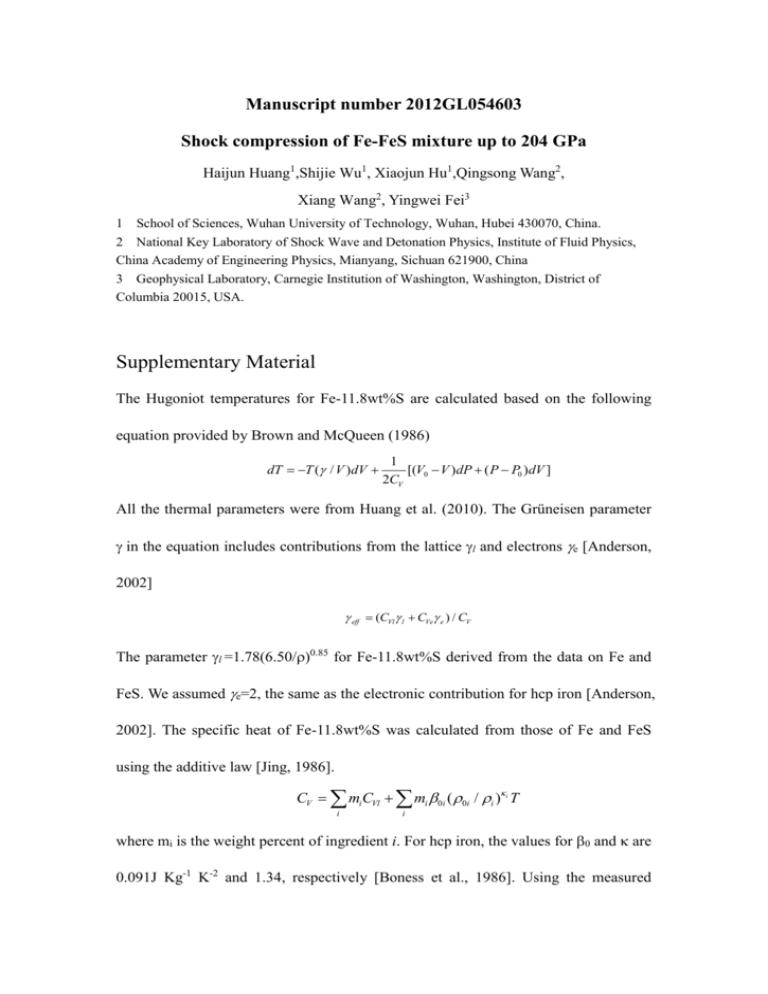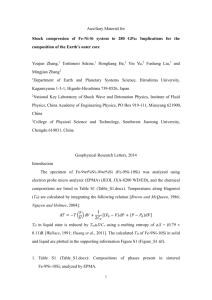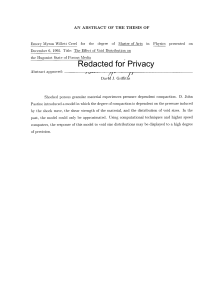supplementary_material
advertisement

Manuscript number 2012GL054603 Shock compression of Fe-FeS mixture up to 204 GPa Haijun Huang1,Shijie Wu1, Xiaojun Hu1,Qingsong Wang2, Xiang Wang2, Yingwei Fei3 1 School of Sciences, Wuhan University of Technology, Wuhan, Hubei 430070, China. 2 National Key Laboratory of Shock Wave and Detonation Physics, Institute of Fluid Physics, China Academy of Engineering Physics, Mianyang, Sichuan 621900, China 3 Geophysical Laboratory, Carnegie Institution of Washington, Washington, District of Columbia 20015, USA. Supplementary Material The Hugoniot temperatures for Fe-11.8wt%S are calculated based on the following equation provided by Brown and McQueen (1986) dT T ( / V )dV 1 [(V0 V )dP ( P P0 )dV ] 2CV All the thermal parameters were from Huang et al. (2010). The Grüneisen parameter in the equation includes contributions from the lattice l and electrons e [Anderson, 2002] eff (CVl l CVe e ) / CV The parameter l =1.78(6.50/)0.85 for Fe-11.8wt%S derived from the data on Fe and FeS. We assumed e=2, the same as the electronic contribution for hcp iron [Anderson, 2002]. The specific heat of Fe-11.8wt%S was calculated from those of Fe and FeS using the additive law [Jing, 1986]. CV mi CVl mi 0i ( 0i / i )i T i i where mi is the weight percent of ingredient i. For hcp iron, the values for 0 and are 0.091J Kg-1 K-2 and 1.34, respectively [Boness et al., 1986]. Using the measured melting curve and the shock melting results of Brown et al (1984) for FeS, Anderson and Ahrens (1996) proposed 0=0.25JKg-1K-2 assuming =1.34. The calculated shock temperature for solid Fe-11.8wt%S intersects the eutectic temperature of the Fe-FeS system [Kamada et al., 2010] at about 96GPa (Fig. 1S). Therefore, the Hugoniot data (94-204 GPa) in this study represent the density of Fe-11.8wt%S liquid. Fig 1S: The calculated shock temperature for Fe-11.8wt%S along Hugoniot (solid line). At about 96GPa, it intersects the eutectic temperature of the Fe-FeS system, shown as dash-dotted line [Kamada et al., 2010], and the dash lines [Morard et al., 2008]. Reference: Anderson, O, L. (2002), The power balance at the core-mantle boundary, Phys. Earth Planet. Inter., 131, 1-17. Anderson, W. W., and T. J. Ahrens (1996), Shock temperature and melting in iron sulfides at core pressures, J. Geophys. Res., 101, 5627-5642. Boness, D. A., J. M. Brown, and A. K. McMahan (1986), The electronic thermodynamics of iron under earth core conditions, Phys. Earth. Planet. Inter., 42, 227-240. Brown, J.M., T.J. Ahrens, and D.L. Shampine (1984), Hugoniot data for pyrrhotite and the Earth’s core, J. Geophys. Res., 89, 6041–6048. Brown. J. M., and R. G.. McQueen (1986), Phase transitions, Gruneisen parameter, and elasticity for shocked iron between77 GPa and 400 GPa, J. Geophys. Res., 91, 7485~7494. Huang, H., X. Hu, F. Jing, L. Cai, Q. Shen, Z. Gong, H. Liu (2010), Melting behavior of Fe-O-S at high pressure: A discussion on the melting depression induced by O and S. J. Geophys. Res., 115, B05207. Jing, F. Q. (1986), Introduction to Experimental Equation of State, 2nd ed, 371 pp., Scientific Press, Beijing.(in Chinese) Kamada, S., H. Terasaki, E. Ohtani, T. Sakai, T. Kikegawa, Y. Ohishi, N. Hirao, N. Sata, T. Kondo (2010), Phase relationships of the Fe–FeS system in conditions up to the Earth's outer core, Earth Planet. Sci., 294 , 94–100. Morard, G.,Andrault,D.,Guignot,N.,Sanloup,C.,Mezouar,M.,Petitgirard,S.,Fiquet, G.(2008), In-situ determination of Fe–Fe3S phase diagram and liquid structural propertiesupto65GPa.Earth Planet.Sci.Lett., 272,620–626.







